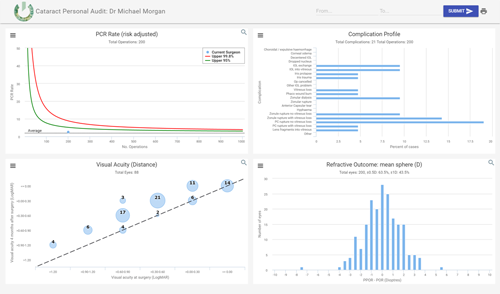Deployment of specialty-driven (or specialty-specific) electronic medical record (EMR) systems across UK ophthalmology units appears to be growing rapidly at the expense of generic, multiuse digital technology packages. Experience further suggests that open source systems can play a significant role alongside proprietary offerings in securing an effective, flexible and configurable EMR solution.
In this feature, ophthalmology EMR providers Medisoft and OpenEyes share respective views on current offerings, and Chris Canning, Chief Clinical Information Officer, Moorfields Eye Hospital, London, discusses taking a multicentre treatment facility to a paperless clinical environment.
Medisoft Ophthalmology and mediSIGHT EMR
Developed by the same senior management team that founded the company 19 years ago, Medisoft’s Ophthalmology EMR system is used by more than 150 hospitals in the UK and abroad. Uptake in other European countries and Australia is growing. The system is used to record clinic visits, assessments, investigations and ophthalmic procedures, allows users to consolidate records and diagnostic images from multiple sites and ophthalmic devices, and to report on practice activity and clinical outcomes.
Medisoft EMR enables audit reports to be compiled based on thousands of visits or operations. Peer-reviewed published examples include rates of posterior capsule rupture across hundreds of cataract surgeons, and clinical outcomes of anti-vascular endothelial growth factor (anti-VEGF) treatment for wet age-related macular degeneration (AMD) patients stratified by baseline vision, dosing regimen and treatment frequency. Should more complex analyses be required, advanced analytical tools are a standard part of the Medisoft system.
In May this year Medisoft launched the first version of its next-generation EMR product, mediSIGHT, designed to provide faster and better all-round operability. All features are designed and evaluated by practicing ophthalmologists, and a community portal provides a direct link to high-street optometrists. Medisoft won a Medical Futures Innovation Award in 2008 and Queen’s Award for Enterprise in Innovation in 2016.
Hospital-wide EMRs are inadequate for specialty ophthalmology practice
Rob Johnston, co-founder and Clinical Director of Medisoft, leads the clinical input to the design of Medisoft’s software and analytics with input from numerous colleagues around the country. Mr Johnston commented: “General purpose hospital-wide electronic health record systems have limited functionality for specialty practice areas such as ophthalmology. Only specialty-specific EMR systems that collect all nationally agreed datasets ratified by The Royal College of Ophthalmologists are fit for purpose in ophthalmology units, and with good interfacing can interoperate with hospital-wide systems.”
Audit capability has always been a major differentiating factor in the evaluation of different EMR applications. Many digital informatics providers have failed previously to gain traction because their EMR offering lacked any credible audit function.
“The number one strength of the Medisoft EMR offering is the ability to produce detailed audit of clinical and treatment outcomes, allowing comparative analyses of country-wide results and practice patterns among ophthalmologists,” argued Mr Johnston. “Analyses of EMR databases support annual appraisal, revalidation, audit, research and service development initiatives.
“In the treatment of neovascular AMD, for example, retrospective EMR database evaluations show large variations in treatment outcomes across multiple clinical centres. Capacity constraints appear to account for the variability seen in service delivery and treatment frequency with intravitreal anti-VEGF therapy. The EMR also supports service redesign that can transform the efficiency of service delivery, particularly in anti-VEGF and glaucoma care pathways.”
Vendor and EMR evaluations
Transitioning from paper charts and notes to a paperless EMR environment can be challenging for busy eye clinics and outpatient departments, and involves a cultural shift away from conventional record keeping. Mr Johnston said that strong clinical leadership is needed to deliver a paperless environment in the NHS hospital eye service.
Clinicians are encouraged to look closely at all available ophthalmology EMR systems. “Audit capability, service support, and all costs should be evaluated, as well as the deployment track record and ability of the provider to interface with the myriad of other systems in hospitals (document management systems, hospital administrative systems, pharmacy systems and diagnostic equipment),” Mr Johnston observed. “When making cost comparisons between EMR systems, it is important to evaluate all the costs (software licences, interfacing to all diagnostic machines and other hospital systems, training, deployment and support), but also to carefully evaluate the savings that can be achieved.”
Potential annual savings shedding paper for a department that handles 50,000 visits a year are estimated at between £200,000 and £300,000, assuming a paper handling and processing cost of at least £4 to £6 per visit.
Medisoft was awarded a contract by The Royal College of Ophthalmologists’ as part of the National Ophthalmology Audit making the cataract module (linked to the hospital administration system and relevant machinery) available for under £5000 for the duration of the audit for all NHS providers of NHS cataract surgery in England & Wales.
Case illustration: Whipps Cross University Hospital
The eye department at Whipps Cross University Hospital sees over 1500 patients each week. Without an EMR system, vast numbers of paper records need to be stored, transported, updated and filed every day. All ophthalmology consultants at Whipps Cross agreed that achieving paperless or paper-lite working with a specialised EMR system had the potential to improve the service efficiency and quality of care in the management of chronic and acute eye conditions. Following a rigorous selection process, the hospital purchased and installed Medisoft Ophthalmology.
“Whilst our eye department hasn’t yet been able to go completely paperless, due to IT limitations (we don’t have the facility to take electronic signatures for example), the Medisoft Ophthalmology system has also allowed us to be virtually paper free,” commented Miss Sudeshna Patra, Clinical Lead for Ophthalmology and Consultant Eye Surgeon, Whipps Cross University Hospital.
Surgeons are encouraged to submit anonymised patient data to The Royal College of Ophthalmologists’ National Ophthalmology Audit to ensure the public will have visibility of outcomes by surgeon and centre. Because all data in the Medisoft system are structured consistently, the relevant data can be extracted automatically, with no effort or change in working practice required.
OpenEyes – clinician-driven open source solution
“OpenEyes™ is a collaborative, clinician designed and driven open-source EMR for ophthalmology that enables practitioners to access all necessary patient information in one place,” explained Professor James Morgan, Consultant Ophthalmologist, University Hospital of Wales, Cardiff, and chairman of the OpenEyes Foundation. “As an open source application, it cannot be sold to third parties, and is protected by the charity OpenEyes Foundation for the benefit of its users.”
Prof Morgan noted that deployment of the OpenEyes EMR system is now well underway, with strong interest across the UK’s hospital eye service.
“OpenEyes EMR application has been installed in more than 20 eye clinic sites within the Moorfields Eye Hospital cluster, is deployed at Cardiff Eye Clinic and Maidstone Hospital, and there is a lengthening list of hospitals that have chosen OpenEyes as their preferred option,” added Prof Morgan. “OpenEyes represents the opportunity for a national EMR ophthalmology platform developed for the benefit of its users. It is important that ophthalmology units have choice when it comes to selecting an appropriate EMR application.
“This collaborative initiative sprang from frustration using poor software in clinical practice and with the aim of eliminating any vendor lock-in inherent with proprietary systems. Our objective is to make available the best-in-class EMR system for ophthalmology at financing levels that are affordable. It is important to realise that the costs associated with OpenEyes will reduce as the user base expands.”
OpenEyes can be configured to meet local needs and the audit offering, which includes real-time analytical data, is maturing across all subspecialty modules. Prof Morgan noted: “Clinical functionality of an EMR system must be balanced by usability and responsivity; often, a ‘fully featured’ software module can diminish its usability in routine practice. OpenEyes has been developed to avoid these pitfalls, and is intuitive, fast and user-friendly.”
Figure 1. Cataract audit display from OpenEyes EMR system.
Seamless platform
OpenEyes consolidates patient information from clinical examination results to images, pathology to correspondence into one easily accessible record. OpenEyes provides fast entry of Systematised Nomenclature of Medicine – Clinical Terms (SNOMED CT-coded) diagnoses and results as well as decision support, outcome analysis and easy-to-interpret summary views of the patient’s care (Figure 1). OpenEyes EMR runs on a web browser to ensure that it can be accessed wherever needed, and includes a graphical user interface allowing icon-based input of clinical data tailored to specific ocular disease states. It was built to connect primary and secondary care as a seamless eye care platform and to support shared care.
OpenEyes unifies data from systems, imaging machines (via DICOM integration) and clinical input into nationally and internationally agreed datasets. These datasets define the different facets of each ophthalmic specialty and can then be used for tracking clinical outcomes, research and development and clinical audit.
The OpenEyes EMR application won last year’s Code4Health open source software (OSS) competition. The award announcement by NHS Code4Health highlighted a well-structured, copyrighted open source project that uses other OSS subprojects with no licence compatibility issues, and free from security vulnerability concerns.
Across Health will oversee installation and support
While OpenEyes is an open source application, it is recommended that clinical installations and support are handled through its commercial partner London-based Across Health, appointed OpenEyes Foundation implementation, integration and support provider. The management team has over 25 years’ experience in delivering successful innovative digital technology solutions within public and health sectors in the UK, Europe and Australia.
Across Health will ensure that clinical data integrates with hospital workflows and Patient Administration Systems (PAS) and that device connections and interfaces are robust.
Jason Brown, Chief Executive Officer and founder of Across Health, commented: “There is renewed energy and interest across the NHS in using gold standard health information models and best-of-breed medical specialty applications working seamlessly within a Trust’s digital ecosystem. Strategically the OpenEyes project has always embraced modern tech, open standards, and the latest working practices. Now with the experience Across Health brings, things are moving forward exponentially, e.g. analytical tools, mobile app integration, community optometrist shared working, RCOphth national cataract audit and future subspecialty audit integration, seamless ophthalmic device integration, and much more.
“Reflecting this strategic approach, we are planning to use openEHR when providing further subspecialty capabilities; openEHR is both a health informatics standard and peer collaboration philosophy. It empowers doctors and clinicians to take control and drive the digital agenda for flexible e-health systems ensuring universal interoperability among all forms of electronic clinical data, including specialty-focused EMR systems, PAS, Labs, EPMA and more. This strategy allows clinicians rather than IT ‘techies’ to directly design best-in-breed clinical informatics for relevant data capture and real-time reporting of clinical performance and outcomes.
“Eye units at both Bolton NHS Foundation Trust and East Kent NHS Foundation Trust have recently chosen to implement OpenEyes EMR system over alternative EMR options specifically because of the project’s forward thinking strategic advantage,” added Mr Brown. “We are also gearing up to deploy OpenEyes at a further 20 additional NHS trusts beyond the original development sites. The OpenEyes application at Moorfields Eye Hospital runs effortlessly on a single server to meet the requirements of 23 separate hospital sites managing 350,000 patients annually, demonstrating the capacity for OpenEyes to handle large clinical populations.”
Paper to EMR implementation in under six weeks
Implementation costs for small NHS Trusts are around £75,000 for taking the big three ophthalmic subspecialties (taken individually, £25,000 each for cataract, glaucoma and medical retina). The installation of modules to support other subspecialties is free thereafter. The annual support and maintenance cost is around £12,000, including support desk, new product capabilities, and improvement updates from the other OpenEyes innovator Trusts.
There is no software licence fee, no vendor lock-in, and no hidden costs or restrictions in accessing data (during or after contract). OpenEyes software can be installed in a single day, either locally or in secure N3 cloud. However, people and professional change management are essential components for successful paper to digital EMR projects, including pathway analysis, user acceptance testing, training and communications – typically taking between four to six weeks, depending on subspecialty.
COMMENTS ARE WELCOME






